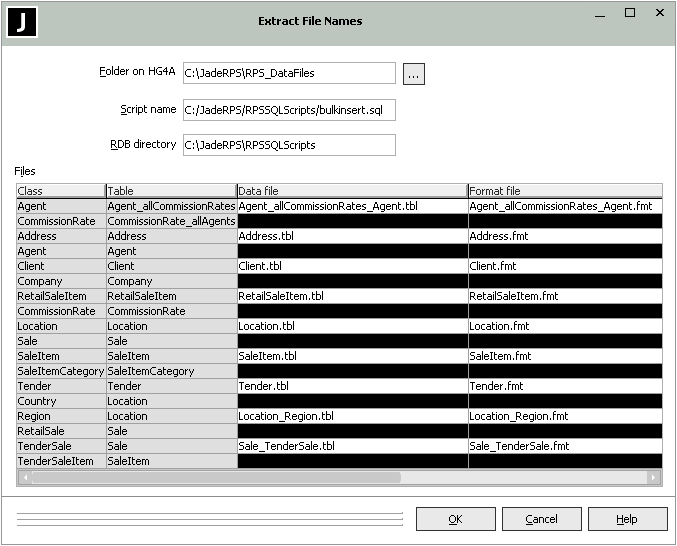Maintaining Extract File Names
If you clicked the Extract File Info button on the Data Extract or Data Extract and Load dialog (that is, you want to override the names of the extract script file or files created by the extract process or to split a data file into two or more partitions), the Extract File Names dialog shown in the following image is then displayed.
To maintain extract file names
-
In the Folder text box, specify the folder to which the table and format files are extracted.
The directory must be valid on the server. If it does not exist, it is created. Alternatively, click the adjacent browse button (indicated by the … points of ellipsis symbol) to display the common Browse for Directory selection dialog that enables you to select the server and directory (folder) to which your extracted files are output.
-
If you want to change the name of the bulk insert script file (for example, a script of the default name exists in the output location and you do not want to overwrite it), specify the required name in the Script name text box.
-
In the RDB Directory text box, change the path location to which data is extracted, if required. The RDB directory is the same as the Folder directory if the Jade RPS node is the same as the RDBMS server node.
The absolute path of the directory is the corresponding RPS configuration value. For details, see "Configuring your RPS Node", earlier in this chapter.
-
In the Data file or Format file column of the Files table, modify the file prefix of each data or format file that you want to change.
-
If you want to load large data tables into the target RDBMS database in parallel, use the # partitions column to specify the number of partitions you want to create for each split data table, to meet your requirements.
You can split each data table into a maximum of 99 partitions. When you click the OK button, the list of data files is checked for duplicate names.
If the number of partitions is greater than 1, the specified table is interpreted as being a list of data files names of the format file-name_01.file-extension, file-name_02.file-extension, and so on up to file-name_nn.file-extension, where the nn value is the specified number of partitions. For example, if you specify your data file name as Sale.tbl that has three partitions, the files created by the extract are Sale_01.tbl, Sale_02.tbl, and Sale_03.tbl.
-
Click the OK button. Alternatively, click the Cancel button to abandon your selections.
The Data Extract or Data Extract and Load dialog from which you accessed the Extract File Names dialog is then displayed.


